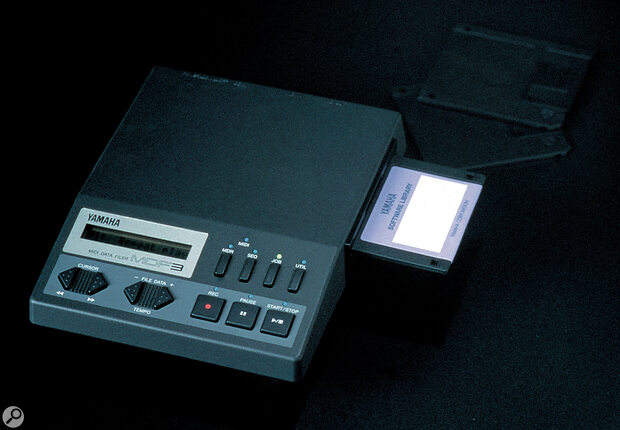There are still plenty of people who just won't have a computer in the studio, but nevertheless need some way of saving MIDI data. Nicholas Rowland checks out the successor to the venerable MDF2.
Just like it says on the tin, a MIDI Data Filer provides a means of filing MIDI data — in other words, it records, stores and transmits MIDI files and System Exclusive patch data. While doing nothing that can't be done by any software sequencer, MIDI data filers can prove useful little beasts. They're great for live sequencing if you don't want to risk gigging your computer. They can also greatly expand the potential of diskless keyboard workstations, offering both access to pre‑recorded MIDI files and a convenient way of recording performances using internal backing tracks. And they're a godsend for anyone still relying on hardware sequencers without disk drives, such as the Alesis MMT8.
Filer Facts
Enter the Yamaha MDF3, successor to the MDF2 (reviewed June 1992). Improvements over the previous model include an upgraded disk drive able to read high‑density as well as double‑density floppies, the ability to read both format 0 and format 1 MIDI files (the MDF2 could only manage the former), and a footswitch input for remote‑controlled starts and stops. Otherwise, its physical appearance and functionality is the same. Like the MDF2, it's very easy to get along with, thanks to its combination of dedicated and multi‑function buttons and associated LEDs.
At the back you'll find a MIDI In, MIDI Out and a footswitch socket, plus the power switch and connection for an 11.5V DC power supply. For the musician on the move, the MDF3 can also run on six AA batteries (not supplied) which yield around three hours of continuous use. The LCD will flash up a battery low message as time begins to run out.
Mode Watch
First stop is MDR mode — MDF3 shorthand for storing and transmitting bulk data files. Note that the MDF3 is fully compatible with any MDR files created using the MDF2, as well as Yamaha's QX3 sequencer.
In SEQ mode the MDF3 will automatically change sequence data into type 0 standard MIDI files. As mentioned above, it will happily play back both type 0 and type 1, along with ESEQ files — a custom Yamaha format used by the likes of the QX3 and Clavinova CVP series. However, due to the way the MDF3 reads and writes its file names, it's not wise to keep SEQ files with MIDI files created by other means on the same disk. That's unless you use a computer to change the file names and fool the MDF3 into thinking they're all SEQ files. (More on this below.) While in SEQ mode, the MDF3 faithfully records and re‑transmits note on and off, polyphonic aftertouch, control change, pitch bend, program change, channel aftertouch and system exclusive messages. In other words, you'll get out what you put in — but obviously there's no way of editing it using the MDF3 itself.
Under Job mode, you can program the MDF3 to play back a number of SEQ data files in a pre‑determined order, or program one or more SEQ files to play in a continuous loop. The Record Tempo option allows you to change a MIDI file's recorded playback tempo, and you can also alter tempos on the fly during playback, using the file data buttons.
The MDF3 will happily sync or swim with other MIDI devices, acting as a slave or master. You can also choose whether it will transmit or respond to MIDI real‑time control messages, for co‑ordination of starts and stops with other devices.
Once files are recorded, you can use the utility menu to rename, delete or append them. One handy utility is the one which details all the files on disk and tells you how much room they occupy. Disks formatted for the MDF3 are compatible with MS‑DOS or PC‑DOS, so they can be read and edited using a PC. Mac and Atari users can also get in on the action via utility software such as PC Exchange and DOS Mounter. As well as allowing you to swap disks of MIDI files between computer and MDF3 with the minimum of fuss, this also allows you to carry out functions which would be somewhat tedious on the MDF3. For example, by renaming the file extensions used by the MDF3 you can change the order of sequencer files played under the Repeat Play function. And if you need to change the setup of your synth during your set, you can change the appropriate MIDI data file to a sequencer file and then transmit it automatically under the Program Play function.
Verdict
And that's all there is to it — the MDF3 functioned just as it was meant to and didn't give me any problems. I have to admit that the prospect of reviewing such a workaday piece of kit didn't exactly set my pulse racing (respect due, Yamaha). Yet after my computer crashed for the third time while in the process of loading some bulk dumps back into my CS1x, I decided that maybe there was a place for the MDF3 on my studio wish list after all. If this review strikes a chord, you'll know you're a potential user too.
Pros
- Neat, chunky design.
- Takes the headache out of MIDI dumps.
- Battery power makes it eminently giggable.
Cons
- LCD not backlit.
- Wouldn't suit sophisticated MIDI setups.
Summary
At this price, probably a luxury for most people, but for the computerless musician, a luxury well worth considering.

